HM Prison and Probation Service workforce quarterly: December 2023
Published 15 February 2024
Applies to England and Wales
Main Points
| 64,517 FTE (full time equivalent) staff in post | This is an increase of 4,648 FTE (7.8%) staff in post compared to 31 December 2022 and a slight increase of 349 FTE (0.5%) since 30 September 2023. The increase seen over the last year is largely driven by an increase of 9.9% (1,852 FTE) in probation staff and an increase of 7.5% (2567 FTE) in Public Sector Prisons. Of the staff in post, there were 36,716 FTE in Public Sector Prisons (PSP), 20,477 FTE staff in the Probation Service, 5,681 FTE staff in HQ and Area Services, and 1,643 FTE in the Youth Custody Service (YCS). |
| 23,266 FTE band 3-5 prison officers in post | This is an increase of 1,634 FTE (7.6%) since 31 December 2022 and a slight increase of 210 FTE (0.9%) prison officers compared to 30 September 2023. |
| 5,451 FTE band 2 operational support staff in post | This is an increase of 282 FTE (5.5%) since 31 December 2022 and a slight increase of 42 FTE (0.8%) operational support staff since 30 September 2023. |
| 4,787 FTE band 4 probation officers in post | This is an increase of 284 FTE (6.3%) since 31 December 2022 and a slight increase of 53 FTE (1.1%) compared to 30 September 2023. In addition to the band 4 probation officers, there were 6,339 FTE band 3 probation services officers: an increase of 130 FTE (2.1%) since 31 December 2022 and a decrease of 302 FTE (4.5%) since 30 September 2023. |
| Leaving rate of 12.6% amongst band 3-5 prison officers | This is a decrease of 1.9 percentage points compared to the year ending 31 March 2023. The overall leaving rate across HMPPS over the past year stood at 11.3%, which is a decrease of 1.2 percentage points compared to the year ending 31 March 2023 of 12.5%. |
| Leaving rate of 8.3% amongst band 4 Probation officers | This is an increase of 0.8 percentage points compared to the year ending 31 March 2023. The leaving rate of band 3 probation services officer over the past 12 months was 11.9%, which is a decrease of 0.5 percentage points compared to the year ending 31 March 2023. |
This publication provides details of staffing levels, staff inflows and outflows, sickness absence rates, and protected characteristics for the directly employed workforce of HMPPS. Information presented covers PSP, the Probation Service, the YCS, and HMPPS headquarters, which includes Area Services that provide direct operational support to prisons. Technical details and explanatory notes can be found in the accompanying Guide to HM Prison and Probation (HMPPS) Workforce Statistics.
Statistician’s comment
In this publication we are reporting on the HMPPS workforce as at 31 December 2023.
As at December 2023, there were 64,517 FTE staff in post which was an increase of 4,648 FTE compared to December 2022. This increase was mainly due to increases in Public Sector Prisons which saw an increase of 2,567 FTE (7.5%) staff since December 2022, with a particular increase in the number of Bands 3-4 / Prison Officer (incl. specialists) of 1,632 FTE (9.0%). Moreover, the Probation Service saw an increase of 1,852 FTE (9.9%) over the same period with an increase across all Probation Service grades, including Senior Probation Officers (9.2%), Probation Officers (6.3%), and Other Band 4-6 (12.2%). In particular, Other Bands 1 to 3 staff saw an increase of 1,181 FTE staff (23.7%), following a centrally run recruitment for key grades supporting front line staff. A contributing factor to the large increases in Probation Service staff has been the acceleration of the recruitment of trainee Probation Officers in previous years. This resulted in the recruitment of 1,514 trainee Probation Officers in the 2022/23 financial year.
Leaving rates fell during the COVID-19 pandemic, possibly due to increased uncertainty in the employment market. Although the latest leaving rates of 11.3% in the year to December 2023 are still higher than pre-pandemic levels, they have decreased by 1.2 percentage points compared to the 12 months to 31 March 2023. In the 12 months to 31 December 2023, there was a total of 7,635 staff who left HMPPS, which is a decrease of 712 (8.5%) compared to the year ending 31 December 2022. This fall was driven by the prison service which saw a reduction of 16.5% in the number of leavers compared to the year ending 31 December 2022, while all other areas of HMPPS saw increases in the number of leavers over the same period.
HMPPS staff sickness accounted for an average of 11.2 working days per person lost for the 12 months to the end of December 2023. This is 0.9 working days higher than the predominantly COVID-19 free year ending 31 March 2020 but is 1.5 working days lower than for the year ending 31 March 2023. For the 12 months to the end of December 2023, the main reason for sickness was Mental and Behavioural Disorders (39.2% of absences) followed by Musculoskeletal System (17.7%), Digestive System (9.1%) and then Respiratory System (9.0%). Epidemic/Pandemic is now 3.9% of absences.
Points to note
HM Prison and Probation Service
HMPPS is focused on supporting operational delivery and the effective running of prison and probation services across the public and private sectors. HMPPS works with a number of partners to carry out the sentences given by the courts, either in custody or the community. This publication covers the reporting period up to 31 December 2023 and therefore considers in detail quarterly staffing levels and staff inflows and outflows, for HMPPS and its predecessors, since 2017.
For ease, the statistics in this publication will be referred to as those of the HMPPS workforce (i.e. staff working in HMPPS and with a contract of employment with HMPPS, excluding those on career breaks and those on secondment or loan outside of HMPPS but including staff on secondment or loan into HMPPS).
Staff employed by private sector establishments and other contractors are excluded. Community Rehabilitation Companies (CRCs) were private-sector suppliers of Probation and Prison-based rehabilitative services for offenders in England and Wales. In late June 2021, more than 7,000 staff from the CRCs came together with probation staff already in the public sector to form the new Probation Service. Prior to this movement, staff employed by CRCs were excluded.
Annex on HMPPS recruitment diversity
This annex, with official statistics in development, presents figures on Prison Officer and Operational Support Grade (OSG) recruitment by diversity characteristics. From June 2021, recruitment statistics were introduced for HMPPS overall, HMPPS HQ, Public Sector Prisons and the Probation Service. This annex runs on a six-monthly production cycle and is only included in the June and December editions.
Annex on Probation Officer Vacancies and Trainees
As of the June 2019 publication, this annex has been added to this bulletin which presents figures on Probation Officers in post, and their required staffing level, in addition it shows the number of trainee and qualified Probation Officers.
Annex on ‘Great Place to Work for Veterans’ recruitment
This annex was introduced in 2022 and presents figures on staff recruited as part of the ‘Great Place to Work for Veterans’ recruitment campaign. This campaign started in April 2022. It is a simple one table annex and is expected to be repeated biannually, in the March and September publications. All externally advertised roles, at all grades across MoJ, utilise the Great place to work for Veterans scheme. This scheme allows eligible veterans to opt into the scheme, providing the opportunity for a guaranteed interview if they meet the minimum sift standard for that vacancy. Further information can be found at: https://www.civil-service-careers.gov.uk/great-place-to-work-for-veterans/
Between 1 February to 16 May 2023, Great Place to Work for Veterans data is not available on the Oleoo Recruitment system due to an unexpected system configuration issue which has now been rectified. This meant that between those dates, whilst eligible candidates could still manually request to opt into the scheme, the system’s automatic opt-in button was hidden and so was unable to produce the required data for inclusion in this report.
Organisational Changes in last two years
-
Following a recent review of the Senior Civil Servants (SCS) data, we have ensured that HMPPS Prison Group Director (PGD) and Regional Probation Director (RPD) roles have been removed from this cohort. PGDs and RPDs moved from SCS Band 1 to a new Band 12 grade via an opt-in exercise over the past 18 months and are therefore now included in operational grades data instead.
-
In June 2022 around 1,000 Approved Premises staff were moved out of HQ directorates and back into Probation Service. This reverses a move from November and December 2019, when over 1,200 NPS staff moved to the Community and Interventions directorate, part of HMPPS HQ and Areas Services. As part of these changes two additional teams were moved in March 2023; AP Professionalisation Project and AP Counter Terrorism and Drug Strategy were moved out the of the HQ directorate of Reducing Reoffending & Accommodation and into Probation directorate of National Approved Premises. Figures for all historical periods have been revised to reflect this change.
-
HMP Aylesbury was part of the Long Term & High Security Estate but moved to South Central Region in October 2022.
Future Plans
For future publications we are considering ways in which we can improve the bulletin, and some of the issues we may look into are as follows:
- How to make the tables and presentation of the figures more user-friendly.
- Whether to and how to expand the range of information provided.
The figures in this bulletin currently exclude some unpaid staff, such as those on career breaks, but includes others, such as those on unpaid maternity/adoption leave. We are currently looking into changing this so all unpaid staff are excluded from this bulletin to align with cross-government guidance. The volume of these staff is very small so this will have little impact on the overall headcount figures. We are also reviewing various aspects of the current methodology with the aim of improving the overall accuracy of the data, including the joiners, leavers and sickness data sets.
If you have any particular comments or views on the above, or any other aspects you would like to be considered about this bulletin, please contact us at the address given at the end of the publication.
1. Total HMPPS staff in post
64,517 FTE staff in post (as at 31 December 2023)
This is an increase of 4,648 FTE (7.8%) staff in post since 31 December 2022 and a slight increase of 349 FTE (0.5%) since 30 September 2023. Of the staff in post, there were 36,716 FTE in Public Sector Prisons (PSP), 20,477 FTE staff in the Probation Service, 5,681 FTE staff in HQ and Area Services, and 1,643 FTE in the Youth Custody Service (YCS).
As at 31 December 2023, there were 64,517 FTE staff in post in HMPPS on a full time equivalent (FTE) basis (Figure 1). This includes 36,716 FTE staff in PSP (making up 56.9% of all HMPPS staff), 20,477 FTE in the Probation Service (31.7% of all HMPPS staff), 5,681 FTE in HMPPS HQ and Area Services (8.8% of all HMPPS staff), and 1,643 FTE in the YCS (2.5% of all HMPPS staff).
Compared to 31 December 2022, the overall staff numbers increased by 4,648 FTE (7.8%): FTE in PSP increased by 2,567 (7.5%), FTE in the Probation Service increased by 1,852 (9.9%), FTE in HQ and Area Services increased by 138 (2.5%), and FTE in the YCS increased by 92 (5.9%).
As at 31 December 2023, there were 29,830 FTE (46.2% of HMPPS staff) operational Prison Service staff (including YCS staff). This is an increase of 1,958 FTE staff (7.0%) compared to 31 December 2022. Non-operational roles across PSP, YCS, and HMPPS HQ accounted for 13,882 FTE staff (21.5% of HMPPS staff), which is an increase of 834 FTE (6.4%) since 31 December 2022. There were 20,806 FTE staff[footnote 2] in the Probation Service (32.2% of all HMPPS staff): an increase of 1,856 (9.8%) FTE since 31 December 2022.
Figure 1 shows a big increase in Probation Service staff in June 2021, which was due to more than 7,000 staff from private sector CRCs coming together with probation staff already in the public sector in the new Probation Service.
Figure 1: Number of HMPPS staff in post on an FTE basis, 31 March 2018 to 31 December 2023 (Source: Table 1)
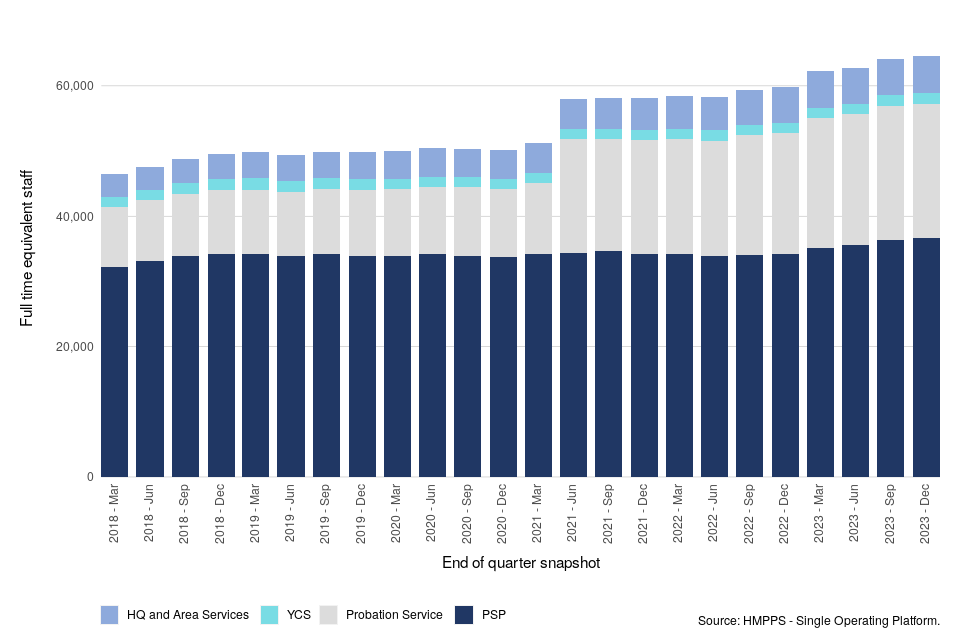
1.1 Length of Service
Due to high numbers of new joiners the average length of service of HMPPS employees has decreased over the last year. Across HMPPS overall, 35.3% of FTE staff in post had less than 3 years’ service, which was an increase from 29.9% at 31 December 2022 and a slight increase from 34.7% at 30 September 2023. 27.2% of HMPPS FTE staff in post had 10 years or more of experience, representing a decrease from 31.1% at 31 December 2022 and a slight decrease from 27.8% at 30 September 2023.
The proportion of band 3-5 prison officers with less than 3 years’ service at 31 December 2023 rose to 40.6% compared to 32.8% as at 31 December 2022. The proportion of band 3-5 prison officers in post with 10 years or more of experience decreased by 5.9 percentage points from 33.1% at 31 December 2022 to 27.1% at 31 December 2023. This corresponds to 6,315 FTE staff with 10 years or more of experience at 31 December 2023, which is a fall of 842 FTE, or 11.8% since 31 December 2022.
The proportion of band 2 OSG FTE staff with less than 3 years’ service increased from 46.7% at 31 December 2022 to 52.2% at 31 December 2023, and the proportion of those with 10 years or more of experience decreased from 30.9% at 31 December 2022 to 26.0% at 31 December 2023.
It should be noted, that the National Probation Service was created on 1 June 2014 and the service of Probation Service staff in Probation Trusts prior to the creation of the Probation Service is not included. Therefore, the figures relating to the length of service of Probation Service staff, which are included in the HMPPS overall figures, do not necessarily represent their full experience but rather the length of service from entry to HMPPS. The situation is different for the over 7,000 staff who transferred from the CRCs in June 2021 and for them their service prior to their date of transfer is included.
Excluding the Probation Service, 35.3% of FTE staff in post across HMPPS had less than 3 years’ service as at 31 December 2023. This is an increase of 5.9 percentage points compared to 31 December 2022.The non-Probation Service staff with 10 years’ experience or more made up 33.6% of the workforce, which is a 4.8 percentage points decrease compared to 31 December 2022.
Length of service information has been calculated for HMPPS staff from the most recent hire date. Where staff have transferred in from another government department or have transferred in through HMPPS taking over a function, length of service is calculated from entry to HMPPS.
2. Band 3-5 prison officers and band 2 operational support staff
23,266 FTE band 3-5 prison officers in post (as at 31 December 2023)
This is an increase of 1,634 FTE (7.6%) in FTE since 31 December 2022 and a slight increase of 210 FTE (0.9%) prison officers compared to 30 September 2023.
5,451 FTE band 2 operational support staff in post (as at 31 December 2023)
This corresponds to an increase of 282 FTE (5.5%) since 31 December 2022 and a slight increase of 42 FTE (0.8%) operational support staff since 30 September 2023.
The key operational grades in public sector prisons are the band 3 to 5 prison officers. They consist of band 3 prison officers, band 4 officer specialists, band 4 supervising officers, and band 5 custodial managers.
Figure 2: Number of band 3-5 prison officers in post on an FTE basis, 31 March 2018 to 31 December 2023 (Source: Table 3)
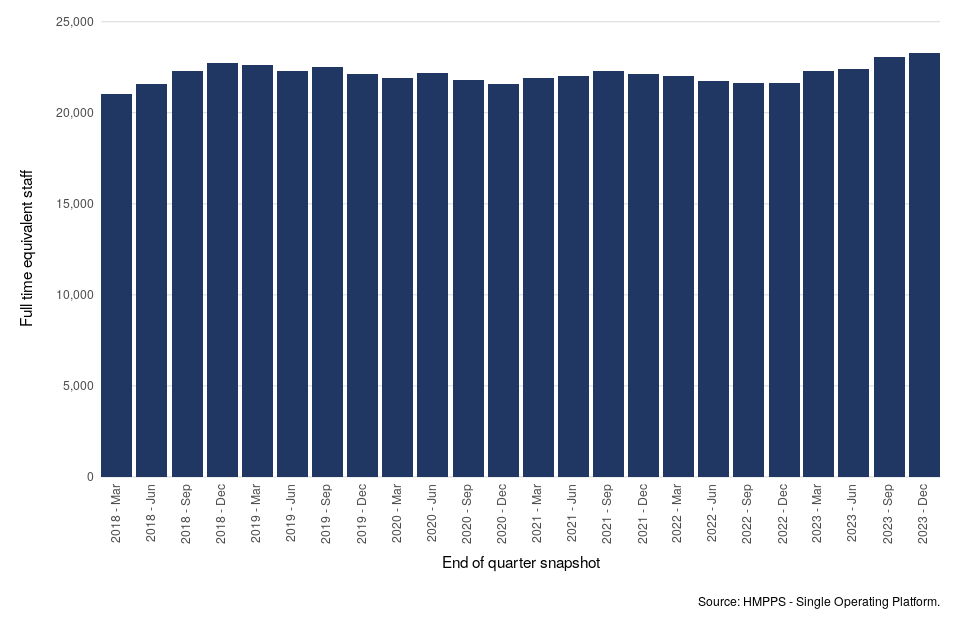
Figure 3 shows a quarterly trend of band 3 to 5 appointments and leavers since 2017/18. Over the year to 31 December 2023, 5,491 band 3 to 5 officers were appointed (consisting of direct new recruits and existing staff who converted to a band 3 officer grade), an increase of 1,429 (35.2%) compared to 4,062 in the previous year. Looking at the quarterly figures, the headcount of new band 3 to 5 officer appointments decreased by 414 (25.7%) from 1,611 between July and September 2023 to 1,197 between October and December 2023 (Table 17).
The headcount of band 3 to 5 prison officers who left HMPPS in the year ending 31 December 2023 was 2,978, which is a decrease of 589 (16.5%) compared to the year ending 31 December 2022. Examining reasons for leaving, 65.8% of prison officers who left in the year ending 31 December 2023 resigned from their roles (down from 69.6% in the year ending 31 December 2022). Of the other prison officers who left HMPPS in the year ending 31 December 2023, 15.0% were dismissed and 6.0% retired; the proportion dismissed are up from 13.8% compared to previous year while the number retiring are down from 6.1%.
Figure 3: Newly appointed band 3 to 5 prison officers and band 3 to 5 prison officer leavers, April 2017 to 31 December 2023 (Source: Table 17)
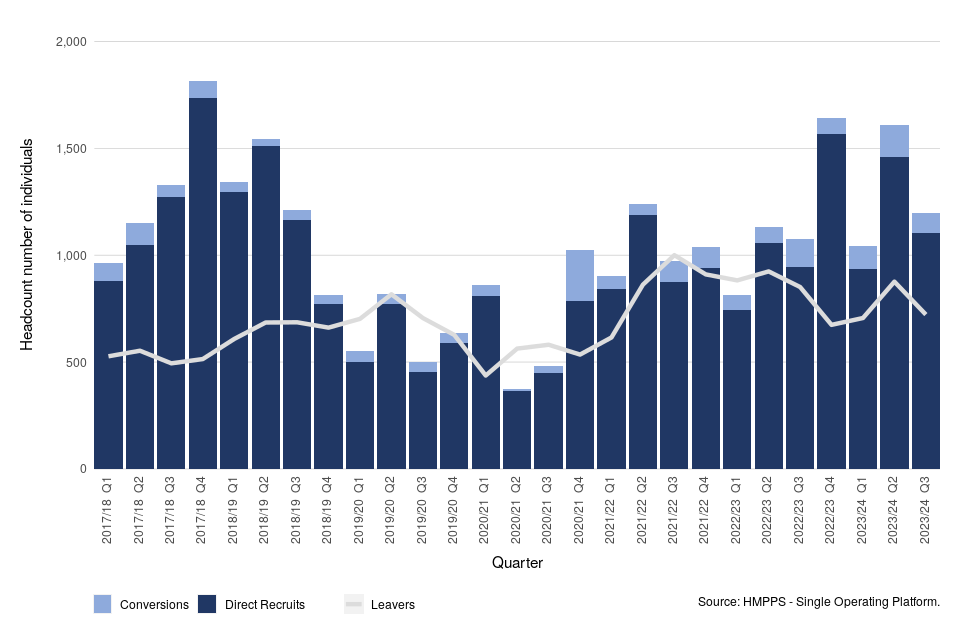
Joiners and leavers are not the only movements into and out of the band 3 to 5 officer grouping. There are also typically differences in the proportion of new joiners and older officers who work part time as well as movements between grades, such as internal movements to non-frontline roles or promotions to operational managers. Changes such as staff switching from full time to part time also have the effect of reducing the FTE of officers available as they progress through their career. For these reasons, the change in FTE does not directly reflect the difference between the number of joiners and leavers.
The number of band 2 OSG staff who joined HMPPS in the year ending 31 December 2023 was 1,886: an increase of 44 (2.4%) compared to the previous year ending 31 December 2022. There was a decrease of 39 (2.0%) since the year ending 30 September 2023. The headcount number of band 2 OSG staff who left HMPPS was 923, which is a decrease of 144 (13.5%) compared to the year ending 31 December 2022 and a decrease of 49 (5.0%) compared to the year ending 30 September 2023.
3. Probation practitioners and senior probation officers
4,787 FTE band 4 probation officers in post (as at 31 December 2023)
This figure is an increase of 284 FTE (6.3%) since 31 December 2022 and a slight increase of 53 FTE (1.1%) probation officers compared to 30 September 2023. In addition to the band 4 probation officers, there were 6,339 FTE band 3 probation services officers: an increase of 130 FTE (2.1%) since 31 December 2022 and a decrease of 302 FTE (4.5%) since 30 September 2023.
Key grades in the Probation Service include band 3 probation services officers, band 4 probation officers (collectively known as probation practitioners), as well as band 5 senior probation officers. Staff who are training to be a probation officer work as a probation services officer during their training, so a proportion of the probation services officers in post will be working towards the professional probation officer qualification.
As of the June 2019 publication, a statistics annex has been added to this bulletin which presents figures on Probation Officers in post, their required staffing level, in addition to the number of trainee and qualified Probation Officers.
As at 31 December 2023, there were 6,339 FTE band 3 probation services officers in post, an increase of 130 FTE (2.1%) over the past year and a decrease of 302 FTE (4.5%) over the quarter. A contributing factor to the net decrease in probation services officers is the qualification of trainee probation officers, with many qualifiers taking up posts at the band 4 qualified probation officer grade. There were 4,787 FTE band 4 probation officers, representing an increase of 284 FTE (6.3%) over the past year and a slight increase of 53 FTE (1.1%) compared to the previous quarter; and 1,490 FTE band 5 senior probation officers, showing an increase of 126 (9.2%) over the previous year and no substantial change since the last quarter (Figure 4).
Figure 4: Number of probation officers, probation services officers and senior probation officers in post on an FTE basis, 31 March 2018 to 31 December 2023 (Source: Table 3)
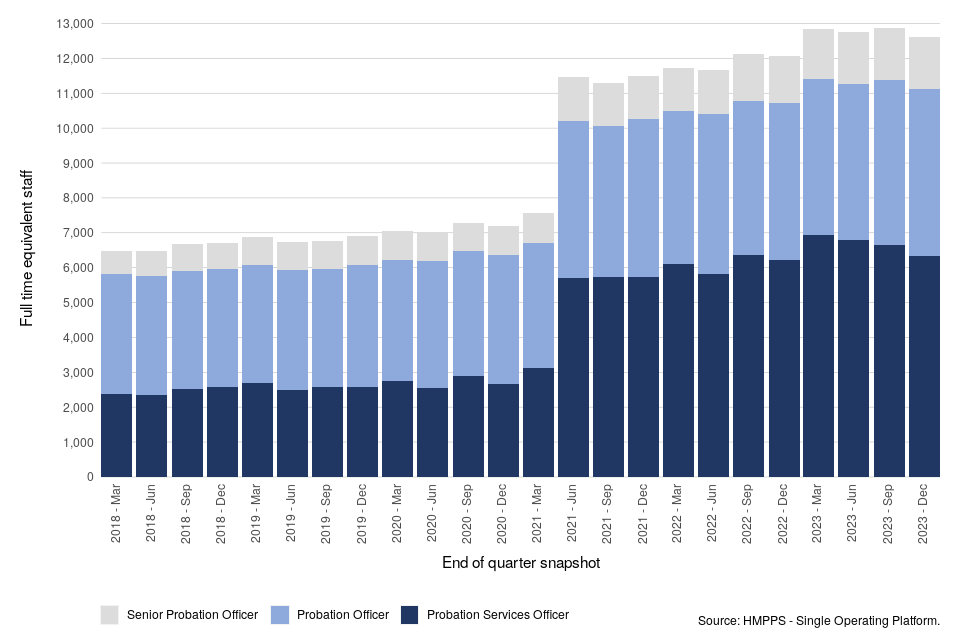
In the past year, 1,908 probation services officers were appointed, some of whom will be training to become qualified probation officers. This is an increase of 88 (4.8%) compared to the year ending 31 December 2022 and a decrease of 229 (10.7%) compared to the number appointed in the year ending 30 September 2023. Within the Probation Service, there were 4,762 FTE Probation Officers in post, a shortfall of 2,031 FTE against the required staffing level of 6,794 FTE. There were 1,666 staff, equivalent to 1,645 FTE, undertaking the PQiP training as at 31 December 2023 (please refer to the Probation Officer Recruitment Annex for more details). In addition to the Probation Officers and current trainees, there were 324 FTE PQiP trainees who had completed their training as at 31 December 2023, but were waiting to take up a substantive Probation Officer post (or in some cases were not in a Probation Officer post for other reasons). In the past year, 835 probation services officers left the service. This is a decrease of 24 (2.8%) compared to the year ending 31 December 2022 and an increase of 40 (5.0%) compared to the number who left in the year ending 30 September 2023.
4. Joiners and Leavers
Leaving rate of 12.6% amongst band 3-5 prison officers (for the 12 months ending 31 December 2023)
This is a decrease of 1.9 percentage points compared to the year ending 31 March 2023. The overall leaving rate across HMPPS over the past year stood at 11.3%, which is a decrease of 1.2 percentage points compared to the year ending 31 March 2023 of 12.5%
Over the past year, 12,423 staff joined HMPPS, which is an increase of 2,619 (26.7%) compared to the year ending 31 December 2022. These joiners consisted of 7,636 across PSP, 425 in the YCS, 4,112 in the Probation Service, and 250 in HMPPS HQ and Area Services. Compared to the year ending 31 December 2022, these numbers of joiners represent an increase of 25.0% for PSP, an increase of 32.8% for YCS, an increase of 33.6% for Probation Service, and a decrease of 15.5% for HMPPS HQ and Area Services.
A contributing factor to the large increases in the Probation Service staff have been the acceleration of the recruitment of trainee Probation Officers in previous years. This has resulted in the recruitment of 1,514 trainee Probation Officers in the 2022/23 financial year. This resource is included in the Band 3 Probation Service Officers grade and therefore influenced the increase in joiners seen at this grade. We continue to run a unified model of recruitment for key operational grades (including Band 3 Probation Service Officers in priority regions). This focused and enhanced model has resulted in a volume of new joiners at these key grades.
This year (2023/24), we are recruiting PQiP (Professional Qualification in Probation) learners through a more concentrated recruitment approach, enabling us to prioritise recruitment of learners in hard to recruit areas and build on the recruitment success we have seen in other regions to work towards increasing Probation Officers staffing whilst smoothing allocation of learners.
There were 7,635 leavers in the year ending 31 December 2023, a decrease of 712 (8.5%)compared to the year ending 31 December 2022. This includes 4,612 leavers from PSP (a decrease of 16.5%), 295 from YCS (an increase of 11.7%), 2,275 from the Probation Service (an increase of 6.0%), and 453 from HMPPS HQ and Area Services (an increase of 9.2%).
4.1 Leaving Rates[footnote 3]
The overall HMPPS leaving rate for the year to 31 December 2023 was 11.3% compared to 12.5% for the year to 31 March 2023 (Figure 5); a decrease of 1.2 percentage points. For the year up to 31 March 2021, the increased uncertainty in the employment market following the COVID-19 pandemic may have contributed to the drop in the number of resignations during most of the year, therefore impacting on the overall reduced leaving and resignation rates. Although the latest leaving rates are still higher than pre-pandemic levels, they have shown a decrease over the last 12 months.
Figure 5: Annual leaving rates of permanent staff in key operational grades (excluding VEDSR), from the 12 months to 31 March 2018 to the 12 months to 31 December 2023 (Source: Table 11)
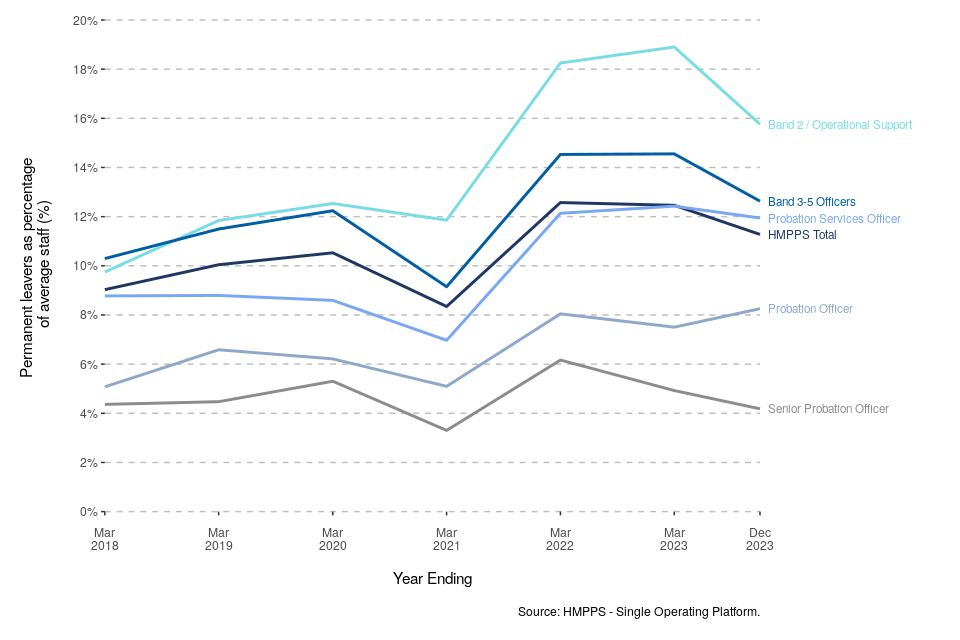
4.2 Resignation Rates[footnote 4]
The overall HMPPS resignation rate for the 12 months to 31 December 2023 was 7.2%, compared to 8.1% for the year to 31 March 2023 (Figure 6). For band 3-5 officers, the resignation rate was 8.3% in the year ending 31 December 2023, which is a decrease of 1.4 percentage points since the year ending 31 March 2023. The resignation rate for OSG staff was 11.6% for the year ending 31 December 2023, which is a decrease of 2.4 percentage points since the year ending 31 March 2023.
For Probation Service overall, the resignation rate was 6.8% for the year ending 31 December 2023. This represents a slight decrease of 0.2 percentage points compared to the year ending 31 March 2023. Amongst the operational grades within the Probation Service, probation services officers had the highest resignation rate at 8.8%, a decrease of 0.9 percentage points since the year ending 31 March 2023.
Figure 6: Annual resignation rates of permanent staff in key operational grades, from the 12 months to 31 March 2018 to the 12 months to 31 December 2023 (Source: Table 12)
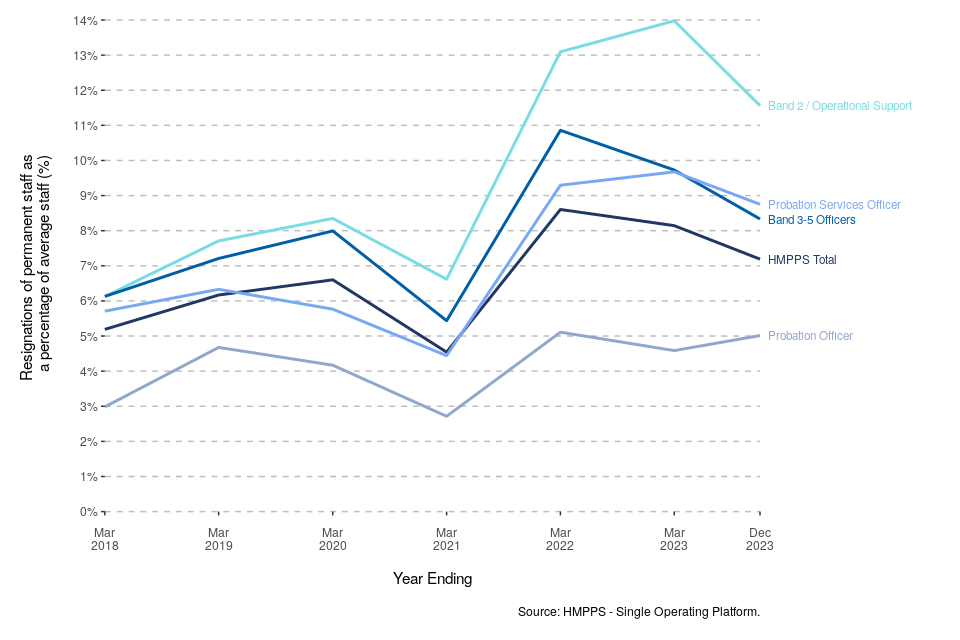
5. Sickness absence
HMPPS staff lost an average of 11.2 working days to sickness absence in the 12 months ending 31 December 2023 (including COVID sickness)
This represents a decrease of 1.5 average working days lost (AWDL) compared to the year ending 31 March 2023 (12.6 working days lost).
In the year ending 31 December 2023, HMPPS staff lost an average of 11.2 working days to sickness absence. This is a decrease from 12.6 average working days lost for the year ending 31 March 2023, and an increase of 0.9 days compared to the predominantly COVID-19 free year ending 31 March 2020.
YCS staff had the highest sickness absence rate at 17.5 AWDL, followed by Probation Service (12.3 AWDL), PSP (11.2 AWDL), and HQ and Area Services (5.6 AWDL) (Figure 7). Compared to the year ending 31 March 2023, these represent a decrease of 0.9 days for YCS, a decrease of 0.4 days for Probation Service, a decrease of 2.2 days for PSP, and a decrease of 0.5 days for HQ and Area Services staff.
Figure 7: Average working days lost to sickness absence, 12 months to 31 March 2018 to 12 months to 31 December 2023 (Source: Table 18)

The most common category of sickness absence in terms of days lost was mental and behavioural disorders, corresponding to 39.2% of working days lost in the past year. This category was most prevalent for probation officers, where 59.2% of working days lost were attributed to mental and behavioural disorders.
For HMPPS overall the category that accounted for the second largest proportion of working days lost was musculoskeletal system (17.7%). Together the top two categories accounted for 57.0% of all working days lost.
Further Information
Accompanying files
As well as this bulletin, the following products are published as part of this release:
-
A technical guide providing details of the HMPPS workforce structure as well as how the data are collected and processed. Information on the revisions policy and disclosure relevant to HMPPS staffing data is also included.
-
A set of summary tables for the latest quarter and year as well as over time.
-
A supplementary annex presenting statistics on Probation Officers in post, their required staffing level, and the number of trainee and qualified Probation Officers.
-
A supplementary annex presenting statistics on the gender, ethnicity and disability status of recruitment campaign applicants for selected HMPPS Grades.
Official statistics
The statistics in this bulletin are classified as official statistics. The Statistics and Registration Service Act 2007 defines ‘official statistics’ as all those statistical outputs produced by the UK Statistics Authority’s executive office (the Office for National Statistics), by central Government departments and agencies, by the devolved administrations in Northern Ireland, Scotland, and Wales, and by other Crown bodies (over 200 bodies in total). The statistics in this bulletin comply with all aspects of the Code of Practice for Official Statistics. The Code encourages and supports producers of statistics to maintain their independence and to ensure adequate resourcing for statistical production. It helps producers and users of statistics by setting out the necessary principles and practices to produce statistics that are trustworthy, high quality and of public value.
Official statistics in development
Official statistics in development are a subset of newly developed or innovative official statistics undergoing evaluation. They are developed under the guidance of the Head of Profession for Statistics (HoP) and published to involve users and stakeholders in the assessment of their suitability and quality at an early stage. Therefore, we would like to receive feedback as to how useful they are, whether a different analysis would be preferable, or any other comments about them. If you wish to send any views you may have about these Official statistics in development, please use the contact details below.
Contact
Press enquiries should be directed to the Ministry of Justice press office:
https://www.gov.uk/government/organisations/ministry-of-justice/about/media-enquiries
Other enquiries about these statistics should be directed to:
Rob Hartley
Corporate Data Sharing Lead
Data and Analysis Directorate
Ministry of Justice
10 South Colonnade
London
E14 4PH
Email: robert.hartley@justice.gov.uk
Next update: 16 May 2024
URL: www.gov.uk/government/collections/national-offender-management-service-workforce-statistics
© Crown copyright
Produced by the Ministry of Justice
Alternative formats are available on request from robert.hartley@justice.gov.uk
-
This includes staff in Probation Service grades working in other parts of HMPPS. ↩
-
Percentage of staff with a permanent contract of employment who left HMPPS, including individuals who have retired early, but excluding staff who left due to voluntary early departure schemes and redundancy (VEDSR). ↩
-
Percentage of staff with a permanent contract of employment who resigned from HMPPS. ↩
